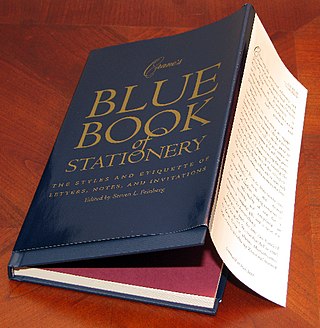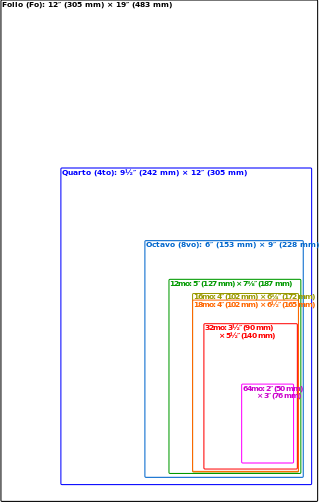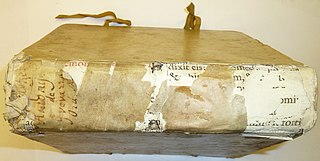
A book is a medium for recording information in the form of writing or images, typically composed of many pages bound together and protected by a cover. It can also be a handwritten or printed work of fiction or nonfiction, usually on sheets of paper fastened or bound together within covers. The technical term for this physical arrangement is codex. In the history of hand-held physical supports for extended written compositions or records, the codex replaces its predecessor, the scroll. A single sheet in a codex is a leaf and each side of a leaf is a page.

The codex was the historical ancestor of the modern book. Instead of being composed of sheets of paper, it used sheets of vellum, papyrus, or other materials. The term codex is often used for ancient manuscript books, with handwritten contents. A codex, much like the modern book, is bound by stacking the pages and securing one set of edges by a variety of methods over the centuries, yet in a form analogous to modern bookbinding. Modern books are divided into paperback and those bound with stiff boards, called hardbacks. Elaborate historical bindings are called treasure bindings. At least in the Western world, the main alternative to the paged codex format for a long document was the continuous scroll, which was the dominant form of document in the ancient world. Some codices are continuously folded like a concertina, in particular the Maya codices and Aztec codices, which are actually long sheets of paper or animal skin folded into pages. In Japan, concertina-style codices called orihon developed during the Heian period (794–1185) were made of paper.
This list contains only complete, printed English-language editions of The Hobbit by J. R. R. Tolkien. It is not for derived or unprinted works such as screenplays, graphic novels, or audio books.

A hardcover, hard cover, or hardback book is one bound with rigid protective covers. It has a flexible, sewn spine which allows the book to lie flat on a surface when opened. Modern hardcovers may have the pages glued onto the spine in much the same way as paperbacks. Following the ISBN sequence numbers, books of this type may be identified by the abbreviation Hbk.

Library binding can be divided into the two major categories of "original" and "after market". The original category is as it says: the book was originally bound with the idea that it would be used in a library setting where the book would receive harder use than those usual trade editions sold to the public.

The dust jacket of a book is the detachable outer cover, usually made of paper and printed with text and illustrations. This outer cover has folded flaps that hold it to the front and back book covers.

Book design is the art of incorporating the content, style, format, design, and sequence of the various components and elements of a book into a coherent unit. In the words of renowned typographer Jan Tschichold (1902–1974), book design, "though largely forgotten today, [relies upon] methods and rules upon which it is impossible to improve, [and which] have been developed over centuries. To produce perfect books, these rules have to be brought back to life and applied". Richard Hendel describes book design as "an arcane subject", and refers to the need for a context to understand what that means.

A treasure binding or jewelled bookbinding is a luxurious book cover using metalwork in gold or silver, jewels, or ivory, perhaps in addition to more usual bookbinding material for book-covers such as leather, velvet, or other cloth. The actual bookbinding technique is the same as for other medieval books, with the folios, normally of vellum, stitched together and bound to wooden cover boards. The metal furnishings of the treasure binding are then fixed, normally by tacks, onto these boards. Treasure bindings appear to have existed from at least Late Antiquity, though there are no surviving examples from so early, and Early Medieval examples are very rare. They were less used by the end of the Middle Ages, but a few continued to be produced in the West even up to the present day, and many more in areas where Eastern Orthodoxy predominated. The bindings were mainly used on grand illuminated manuscripts, especially gospel books designed for the altar and use in church services, rather than study in the library.

The size of a book is generally measured by the height against the width of a leaf, or sometimes the height and width of its cover. A series of terms is commonly used by libraries and publishers for the general sizes of modern books, ranging from folio, to quarto (smaller) and octavo. Historically, these terms referred to the format of the book, a technical term used by printers and bibliographers to indicate the size of a leaf in terms of the size of the original sheet. For example, a quarto historically was a book printed on sheets of paper folded in half twice, with the first fold at right angles to the second, to produce 4 leaves, each leaf one fourth the size of the original sheet printed – note that a leaf refers to the single piece of paper, whereas a page is one side of a leaf. Because the actual format of many modern books cannot be determined from examination of the books, bibliographers may not use these terms in scholarly descriptions.

Wasōbon is a traditional book style in Japan that dates from the late eighth century AD with the printing of "Hyakumantō Darani" during the reign of Empress Shōtoku (764-770AD). The majority of books were hand-copied until the Edo period (1603–1867), when woodblock printing became comparatively affordable and widespread. Movable-type printing had been used from the late 16th century, but for various aesthetic and practical reasons woodblock printing and hand-copied remained dominant until much later. Japanese equivalents for "book" include 本 (hon) and 書籍 (shoseki). The former term indicates only bound books, and does not include scrolls. The latter is used for printed matter only. The most general term is 書物 (shomotsu), which means all written or printed matter that has been collected into a single unit, regardless of construction.

Traditional Chinese bookbinding, also called stitched binding, is the method of bookbinding that the Chinese, Koreans, Japanese, and Vietnamese used before adopting the modern codex form.

Bindery refers to a studio, workshop or factory where sheets of (usually) paper are fastened together to make books, but also where gold and other decorative elements are added to the exterior of books, where boxes or slipcases for books are made and where the restoration of books is carried out.

Coptic binding or Coptic sewing comprises methods of bookbinding employed by early Christians in Egypt, the Copts, and used from as early as the 2nd century AD to the 11th century. The term is also used to describe modern bindings sewn in the same style.

In bookbinding, a section, gathering, or signature is a group of sheets folded in half, to be worked into the binding as a unit.
Oversewn bindings are a type of bookbinding produced by sewing together loose leaves of paper to form a text block. Threads pass through small holes that have been punched in the signature's gutter margin, forming overlock stitches that attach it to previously attached sections. This method of stitching is sometimes called stab sewing. A piece of linen is then glued to the text block spine for further support. The book's spine may be rounded and backed to keep it from caving in, but if the text block is too thick, the spine is sometimes left flat. A strip of cloth called a super is then often affixed to the spine of the text block and then to the boards of the case. Oversewing can be done by hand but is usually done with a machine in a bindery.

An intentionally blank page or vacat page is a page that has no content and may be unexpected. Such pages may serve purposes ranging from place-holding to space-filling and content separation. Sometimes, these pages carry a notice such as "This page intentionally left blank." Such notices typically appear in printed works, such as legal documents, manuals, and exam papers, in which the reader might otherwise suspect that the blank pages are due to a printing error and where missing pages might have serious consequences.

Bookbinding is the process of building a book, usually in codex format, from an ordered stack of paper sheets with one's hands and tools, or in modern publishing, by automated processes. Firstly, one binds the sheets of papers along an edge with a thick needle and strong thread. One can also use loose-leaf rings, binding posts, twin-loop spine coils, plastic spiral coils, and plastic spine combs, but they last for a shorter time. Next, one encloses the bound stack of paper in a cover. Finally, one places an attractive cover onto the boards, and features the publisher's information and artistic decorations.

The following outline is provided as an overview of and topical guide to books:

Fragmentology is the study of surviving fragments of manuscripts. A manuscript fragment may consist of whole or partial leaves, typically made of parchment, conjugate pairs or sometimes gatherings of a parchment book or codex, or parts of single-leaf documents such as notarial acts. They are commonly found in book bindings, especially printed books from the 15th to the 17th centuries, used in a variety of ways such as wrappers or covers for the book, as endpapers, or cut into pieces and used to reinforce the binding. In other non-Western manuscript cultures, fragments of paper manuscripts and other materials, takes place beside parchment, including board covers that many times reused written paper.

Binding waste is damaged, misprinted, or surplus paper or parchment reused in bookbinding. Whether as whole sheets or fragments, these may be used as the exterior binding, as the endpapers, or as a reinforcement beneath the spine.




















